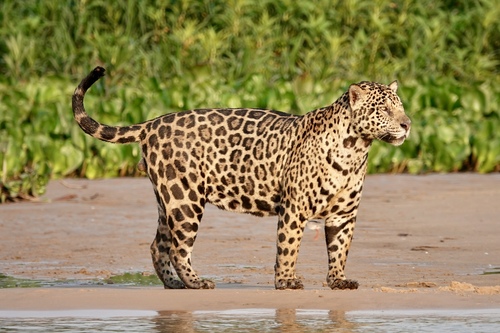
Jaguar
The jaguar, Panthera onca, is a majestic predator of the Americas. Its striking coat and formidable jaws make it a master hunter. As a keystone species, it plays a vital role in maintaining ecological balance, highlighting the intricate dance of survival in its lush habitats.
12-15 years
Lifespan
36.0 kg
Weight
Length: 1.1 - 1.9 m
Size
Brown, Yellow, Black, White, Tan
Color
3-4 years
Age of Sexual Maturity
3 months
Age of Weaning
50 mph
Top Speed
Near Threatened
Conservation Status
Decreasing
Population Trend
Characteristics
Panthera onca, known as the jaguar, is a large feline native to the Americas. It thrives in diverse habitats, from rainforests to scrublands. Notable for its powerful build, the jaguar is an apex predator with a unique bite force capable of piercing turtle shells. Its spotted coat provides excellent camouflage, aiding in its ambush hunting strategy.
Distribution Range of the Jaguar
Panthera onca, commonly known as the jaguar, is native to the Americas. Its range historically covered parts of the United States, extending through Central America, and reaching as far south as Argentina in South America. Today, its primary range includes the Amazon rainforest in South America, particularly in countries like Brazil, Peru, and Bolivia. Jaguars are also found in parts of Mexico and Central American countries such as Guatemala and Honduras.
Jaguar's Habitat
Environmental Conditions
Jaguars typically inhabit dense rainforests, preferring tropical and subtropical forest environments. They are also found in other habitats such as swamps, grasslands, and open terrains, but these are less common. The species thrives in areas with dense cover and proximity to water sources, such as rivers or wetlands, which are crucial for their hunting strategy and survival.
Ecological Niche
As apex predators, jaguars play a crucial role in their ecological niche by maintaining the balance of prey populations. They are solitary hunters, primarily preying on medium to large-sized mammals, including deer, capybaras, and tapirs. Jaguars have adapted to be powerful swimmers, which allows them to hunt aquatic or semi-aquatic prey, further highlighting their adaptability to varied environmental conditions within their habitat range.
Copyright @ Nature Style Limited. All Rights Reserved.
 English
English